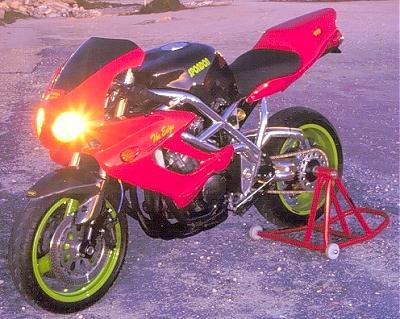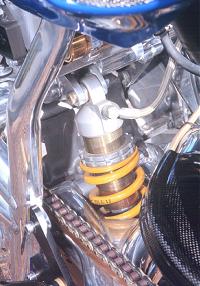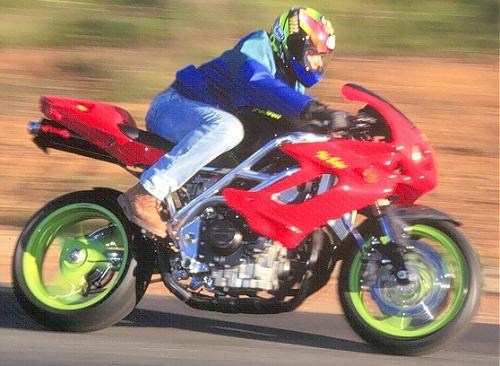Story & images:- RICK McDowell
The problem with chassis kits is that all you get with them is simply that – a chassis.
Well perhaps a swingarm too, yet you still have to fabricate a custom fairing, find a machine shop to manufacture all sorts of brackets and linkages, and then there’s the motorcycle electrics expert who will have to weave a custom harness (or butcher an original).
 Even with all of these matters sorted, you’ll still have to source your own wheels, brakes, suspension …. little wonder then that only a very few opt for the sheer unadulterated luxury and exotic individuality offered by outfits such as Spondon, Harris etc.
Even with all of these matters sorted, you’ll still have to source your own wheels, brakes, suspension …. little wonder then that only a very few opt for the sheer unadulterated luxury and exotic individuality offered by outfits such as Spondon, Harris etc.
Because make no mistake about it, such chassis are exquisite pieces of engineering, produced by craftsmen whose skills are akin to those of a medieval Wizard.spon3.jpg (33307 bytes)
Skills, it has to be said, that can never be re-produced by mass production in a Japanese factory.
The handling capabilities and the character of bikes built from these chassis kits is also out of this World, yet all of the dramas involved in actually building such two wheeled wonderments means that only a select few actually do.
It’s a situation that Englishman Gary Robinson is very well aware of.
Nobody denies that Spondon chassis are an exclusive item and the number brought Down Under so far can be counted on the fingers of one hand – well maybe two!
The list includes framework for a couple of GP 250cc race bikes, several Harleys, an 851 Ducati and a couple of Fireblade Honda kits.
Said Gary,
“To own a Spondon you don’t need to be rich. In fact, I have never met a rich Spondon owner. It isn’t down to money – it’s down to wanting one enough to do anything to get it. You have to be obsessed by their beauty and if you want one I hope you are either single or have a very understanding partner !”
For all the above mentioned reasons of course, many Spondon Chassis struggle to evolve into complete, rideable motorcycles
Spondon make chassis for just about all of the present big-bore bikes on the market and their GSX-R Suzuki kits are actually good enough for Germany’s bureaucrats, who impose some of the toughest vehicle standards in Europe.
 With a wet weight of 170kg, the Spondon is a good 10 – 15kg or so lighter than the ‘real’ blade (depending on year and model of course) and Gary says that this figure could be reduced down to as much as 160kg !
With a wet weight of 170kg, the Spondon is a good 10 – 15kg or so lighter than the ‘real’ blade (depending on year and model of course) and Gary says that this figure could be reduced down to as much as 160kg !
Perhaps surprisingly, the Spondon is a little longer than the average Fireblade at 1410mm and the head angle is a very similar 24 degrees.
“If you’ve never ridden a racing bike – and never intend racing but still want to ride a pure pukka racer – then a Spondon is the bike for you,” stated Gary.
“The weight is all in the right places, the suspension is the best you can get and they don’t pull into corners or have to be pushed in either. The handling is perfect if you like to ride a fast bike.”
Eagle eyed readers will notice that the brakes and suspension on the Awesome Imports Spondon Fireblade are anything but Honda Fireblade items – they are largely ZX-9R Kawasaki fare.
“There’s no point building a bike like this if it hasn’t got USD forks and six-pot calipers,” explained Gary. “True, we could have used more expensive items, but the Kawasaki gear keeps the cost within reason and it’s all good equipment too.”
Admittedly, Gary has supplemented the Kawasaki front calipers with fully floating 320mm Spondon discs.
Up top the 46mm-diameter Kawasaki forks suspend from offset adjustable Spondon triple clamps, so the head angle probably could be reduced down to a more nervous 23 or 22 degrees.
sponshock.jpg (16309 bytes)Out back and there has certainly been no cost cutting in regards to the rear suspension, with a fully adjustable Ohlins unit on board.
The rear braking system comprises a 300mm Spondon fixed disc gripped by one of Brembo’s renowned Goldline four-spot calipers
Now, if you’ve been reading thus far and are going mental trying to figure out what the bodywork on Gary’s creation is, wonder no longer.
The fairing is a Honda VTR copy, while the seat, ducktail and front mudguard is ZX-9R Kawasaki.
As you’d expect, there’s more than a few customisations with the bodywork such as the heat exhausts cut into the seat to allow the hot air from those under seat Wolf exhausts to escape.
The exhaust system as a whole is a mix of original Honda CBR 900 and custom piping, made up by a bloke called Paul Pinfold.
Road race fans from a few years back might recognize that name, as Pinfold was involved with Graeme Crosby’s race efforts in the good ‘ol days.
Gary admits that there is still some work to be done on the exhaust system with his Spondon Fireblade, but the very interesting 4-into-2-into-1-into-2 combination will remain.
With a machine as unique and individual as this, it would be impossible to discuss every little detail.
“I’ve calculated that a complete Spondon Fireblade could be built for around $25,000,” explained Gary, “but of course, it wouldn’t be hard to spend $100,000 either !”
Gary himself has added a number of purely personal aspects to this initial prototype, including the carbon fibre covering over the hand beaten alloy Spondon petrol tank.
THE SPONDON FILES
Spondon is actually the name of a village in Derbyshire, England.
It was here in 1969 that Bob Stevenson and Stuart Tiller got together to start their motorcycle engineering business.
In the mid 1960s when BSA Gold Stars were still useable for club racing, Stevenson figured he could improve things by manufacturing his own frame.
The BSA project never really eventuated, but when Stevenson began working with a custom chassis and a Greeves engine, things really took off.
Dissatisfied with his engineering job at Rolls Royce, Stevenson teamed up with good friend, Stuart Tiller, and the rest is history.
One of their very early success stories involved a custom chassis for Yamaha’s 125cc engine in the early 70s.
Soon there were chassis’ for 250cc and 350cc machines, culminating in Germany’s Martin Wimmer winning the 1982 British 250cc GP Championship on a Spondon framed Yamaha.
There were numerous British Championship wins for Spondon in those days too and even Barry Sheene had a Spondon connection.
This connection to road racing is crucial to the Spondon story.
A similar situation in some ways to Bimota, who also manufactured chassis for GP racers in the 70s and early 80s.
Whereas the Italian specialists had begun working with road bikes by the mid-1980s, it took Spondon until the end of the decade and as Stevenson himself explained in an open and friendly phone conversation,
“We did have a number of one-off beam frames for road bikes made by the mid-80s, but by the start of the 90s it was clear that people weren’t going to throw their Japanese GP frames away any more because they were by now so good. Obviously we had to find another avenue.”
By this stage Spondon had of course become involved in the Norton rotary project, supplying the huge – but light – beam section frame for the F1.
They were glorious days for UK racing too, with Steve Spray, Trevor Nation and Robert Dunlop all scoring wins for the resurrected Norton Marque.
The most memorable victory though, was undoubtedly Steve Hislop’s 1992 Isle Of Man TT Senior win on the Spondon framed Norton at an average speed of 121.28mph – a speed that is still the fastest average around the infamous Mountain Circuit.
The Roton that evolved from the F1 Norton (we will leave the intense political situation associated with that one well alone !) continued the Spondon success story, with Ian Simpson winning back-to-back British F1 Championships in 1994 and 1995.
While all of this road racing was going on in full public view, Spondon were busy jigging up and manufacturing frames for a variety of road bike engines.
Nothing is mass produced at Spondon, but chances are that if you want a chassis for a GSX 1100 motor or a GSX-R1100, the English frame specialists can find the appropriate jigs and perform their acts of wizardry.
Remember too, that a Spondon chassis carries more than twenty years of racing heritage, so lightness and absolute rigidity are fundamental features, even with their road bike chassis.
It’s interesting to note too, that while Spondon have made beam style chassis in the past, their main focus today is on tube construction – for good reason too.
“Our customers want something that looks completely different to what comes off the production lines in Japan and Italy,” stated Stevenson.
“There’s also the subtle fact that tube frames hark back to a classic era, but we can now manufacture them to very modern standards.”
Indeed.
The Fireblade chassis featured here has been welded together from aluminium round tube to 7020 T6 TF condition and T.I.G welded in accordance with specifications EN 288-4.
Spondon’s GSX-R chassis has recently been granted Germany’s T.U.V approval and the Fireblade chassis, manufactured to the exact same standard, is soon to follow suit.
MODEL – Spondon Honda Fireblade
CHASSIS – Spondon aluminium round tube with Spondon single sided swingarm
MOTOR, GEARBOX & CLUTCH – Stock 1998 CBR 900RR Honda
EXHAUST SYSTEM – Mix of Honda CBR 900RR piping and custom piping with dual Wolf mufflers ‘under seat’
FRONT END – Kawasaki 46mm ZX-9R USD forks hung from Spondon offset adjustable triple clamps
Spondon alloy clip ons
Spondon 320mm discs & Kawasaki ZX-9R calipers
ZX-9R 3.5″ X 17″ front wheel – 120 / 70 / 17 Dunlop D207 tyre
REAR END – Ohlins multi adjustable shock absorber Spondon 300mm disc & Brembo Goldline four-spot caliper Marvic 17″ X 6″ rear wheel 190 / 50 /17 Dunlop D207 tyre
BODYWORK – Honda VTR 1000 Firestorm fairing, modified Kawasaki ZX-9R seat unit, Kawasaki ZX-9R front mudguard, custom ‘hugger’ carbon fibre rear mudguard
ELECTRICS – Custom wiring harness based on Honda CBR 900RR
BITS N’ PIECES
Spondon Alloy hand beaten fuel tank, mirrors, side stand, custom brackets, tank pad, screen, Regina chain, Spondon alloy radiator etc.
























